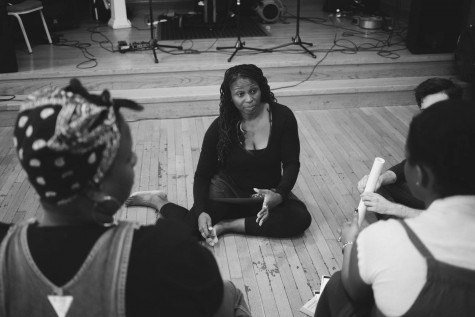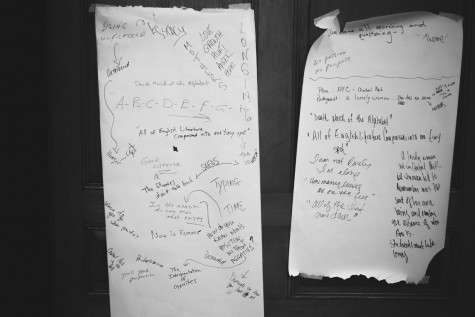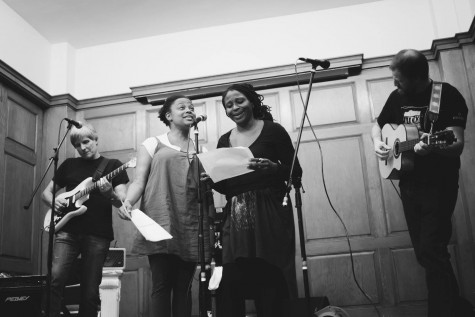
Written by Tanisha Christie
Having the chance to just to be in a room with other artists from disparate disciplines, at different stages of their career was priceless. I would have never met this group of people. Sure, we might have run across each other at some point in the very small world of theater but to sit in a room, sharing ideas and perspectives and not make anything actually gave me the space to figure out what about theater and performance was of interest to me. Here is my short list:
The Audience: engaging the audiences in some way that can allow them to be active makers, instead of voyeurs in the process of “making a show.” (See: Postshow Theater by Robert Quillen Camp and Gavin Kroeber)
Collaboration: having had experienced deep ensemble work in my career as a theater maker, I missed “playing” with a group of artists.
Words: thoughts and ideas but not necessarily full narratives or characters.
Music: well, maybe even more so song. And the idea of “jamming.” That free form collaboration that musicians can do.
After producing a film, I admit I have become married to “outcome.” Being caught in perfection and “producing” something for consumption became a great way to kill the muse or “choke the creative baby.” With the help of my cohort, it was just decided that I needed to make a “performance mess.”

per·for·mance /pərˈfôrməns/ noun.
1. an act of staging or presenting a play, concert, or other form of entertainment.
2. the action or process of carrying out or accomplishing an action, task, or function.
mess /mes/ noun.
2. a situation or state of affairs that is confused or full of difficulties.
Well, this was tricky because I still had to come up with the pieces to make a mess with AND it was decided that I think too much so, it was important to the process not to think too much about it.
Ok! Now I was sufficiently challenged but what would this “performance mess” be about? Thematically, my artwork focuses on the performative and mediated black, feminine identity within the United States; the protracted experiences of violence; a longitudinal study of the immigrant experience; and the ideas that permeate in attaining emotional and social justice. But I did not want the project to overtly focus on these concepts but at the very least “cast” my project with these ideas in mind and give the mess some shape via a few parameters:
Actors/Words: I asked two other black actresses to join me. My question to them was “what roles would you like to play or songs to sing that you would never be cast, in a traditional setting?”
Audience: I invited a few people to act as audience/participants. Since this was a new idea, I wanted to give this “mess” a chance.
Music: Serendipitously, I went to a bar and stumbled upon a house band that was interested in collaborating on this idea. And, it was great because they were all white men; constructing my cast in a way to have a meta-conversation about race, sex, class and whatever other -ism can be thrown at this configuration.
The night before I created a workshop format where we got to know each other, discussed some thematic ideas and then put those ideas on their feet using the texts, words and music we brought with us.
The outcome…..(drum roll)…..was a very structured “mess” that was in the form of a 30-minute showing.

Here were some discoveries:
Actors/Texts/Words: One actress brought the novel, Gone With the Wind, for me that was the most exciting because it created an entire narrative with her simply reading the book in front of the band. We also realized we needed more texts to play with.
Music: The process of creating new songs or doing live mash-ups was invigorating for the band.
The Audience: Throughout the course of the performance we acted as audience/participants and became “set” in our work. In the end, we couldn’t help but be on the road to make something. To develop an idea that had happened spontaneously. But at the end of the day, I had invited one audience member. What was evocative for him was not knowing who was “the audience” versus who were “the performers.”
My role: It was difficult to shake “producer.” In the past, I have gravitated toward using improvisational theatre-dance aesthetic. I did miss that in this exploration but something that can be easily added.
Often devised theatrical work aims to be inclusive of the audience, but does not always include them in the narrative. Is it possible to give space for audience inclusion, reaction and response within the performance? Social media has been shifting the way we respond to each other, in grief, in crisis, in disagreements, in politics and I think in art. Some might argue it is just releasing outward what has always been yet live performance is corporeal and visceral and in the moment. This is the type of engagement I’d like to continue to explore and continue pushing myself to make a mess.
It’s liberating.
Tanisha Christine is a filmmaker, producer, educator and performer, based in Brooklyn, NY.
www.tanishachristie.com